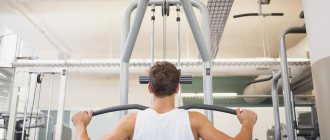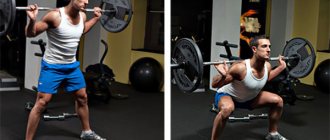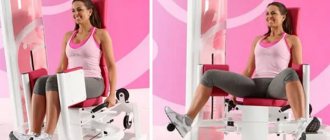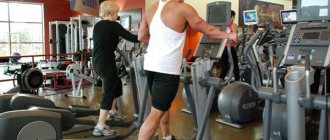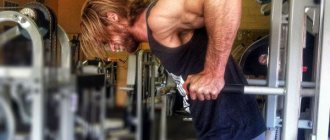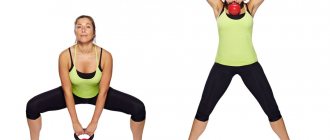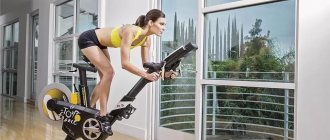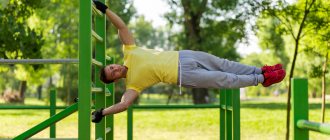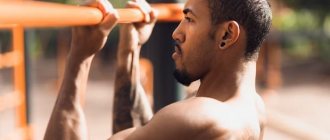Content
- 1 Pull-ups on the horizontal bar 1.1 How to learn to do pull-ups (video)
- 1.2 Pull-up technique
Weighted pull-ups[edit | edit code]
If you do more than 8-10 pull-ups in one set, then you are better off using the weighted pull-up technique. To do this, you need to hang additional weight on your belt,
Weighted pull-up technique: attach additional weight to your belt (see video), take the starting position - hands on the bar with a grip shoulder-width apart or slightly wider, legs bent at the knees (not important). As you exhale, begin to pull your body towards the bar. Lift up until it intersects your chin and then return to the starting position.
Try to perform pull-ups smoothly, do not make sudden movements, they reduce the effectiveness of the exercise.
Muscles involved in different types of grip
You need to study information about what types of pull-ups on the horizontal bar exist. Depending on the exercise chosen, different muscle groups will be involved. This point must be taken into account in order to correctly develop a scheme for further classes.
Types of pull-ups on the horizontal bar
Wide behind the head and towards the chest
Starting the topic of which muscles work on the horizontal bar when pulling up to the chest, it is worth noting that this exercise is considered one of the most useful. The emphasis when performing it is on the following groups of muscle tissue:
- round steam rooms;
- trapezoidal.
True, not everyone can perform the exercise correctly. If you do not adhere to the technique, the desired result is simply not achieved. You need to do the following:
- Grasp the horizontal bar with approximately the same grip as when performing a barbell bench press.
- The crossbar is grasped from above with your thumbs.
- When bringing the shoulder blades together, a pull-up is performed, but the biceps remain relaxed. The upper part of the chest needs to touch the projectile.
- Literally linger at the top for seconds and return to the original position.
Push-ups on the horizontal bar with a wide head grip are considered dangerous. To avoid problems, the exercise is performed strictly according to the rules. It is made using the following technology:
- The grip width is exactly the same as in the previous case.
- When pulling up, the back does not bend.
- The legs are straightened and placed in line with the torso.
- Deflection of the elbow joints back is unacceptable. They are located straight down.
It’s worth figuring out which muscles work when doing pull-ups on the horizontal bar. The widest muscles (center and top), round pairs are involved. In addition, the athlete also pumps the trapezius during the training.
If you perform the exercise on the horizontal bar with a wide grip on the head carelessly or too often, there is a risk of injury. They can also be provoked by very weak joint mobility in the shoulder area.
Middle top and bottom
The method of pulling up on a horizontal bar with a medium overhand grip is considered classic. This exercise develops the muscle tissue of the back, shoulders and biceps. It is performed according to the following scheme:
- Hands on the bar are shoulder-width apart.
- The athlete sags with his legs crossed and his back slightly arched.
- You need to pull yourself up, squeezing your shoulder blades together and touching your chest to the apparatus.
- When returning to the lowest point, the arms are fully straightened.
Push-ups with a medium grip from below are a little easier. The maximum tension is observed in the biceps area. The muscles in the back area also become tense when tightening. Hands on the bar are shoulder-width apart, but the grip is with your palms facing you. When lifting to the top point, the shoulders are pulled back and down.
Narrow grip
The narrow grip deserves special attention. In this case, not just one muscle group is involved, but many. The athlete tenses the lower lats, biceps, as well as the shoulder and serratus muscle tissues. The exercise involves the following actions:
- The athlete hangs on the horizontal bar. His hands are located fairly close to each other, but not excessively.
- The back sags a little.
- Pull-ups are performed by touching the bottom of the chest to the bar.
When doing push-ups you need to be extremely careful. It is extremely important to ensure that as you lift, your shoulders are pulled back and your shoulder blades are retracted. When you reach the top point, you should bend your back more strongly.
Parallel grip
Narrow grip
Neutral along the crossbar
During this exercise, the athlete uses several muscle groups. Not only the lower lats are tense, but also the shoulder and serratus muscles. The training takes place according to the following scheme:
- The athlete grabs the apparatus in such a way that one of the fists is located in front of the other.
- When lifting, the back actively bends.
- You need to touch the horizontal bar with your lower chest.
- When the top point is reached, the head is moved to the side. And from time to time to another.
With each approach, you must definitely change the position of your hands. Otherwise, the load on the muscles will be uneven.
Partial pull-ups
The exercise is a kind of biceps curl that uses a bar. This is exactly how many famous bodybuilders prefer to swing. The maximum tension is observed in the biceps brachii muscle.
When performing, you need to grab the projectile with a reverse medium grip and rise to halfway. In this position, the body is fixed strictly at a right angle to the floor. The arms are bent. The athlete makes every effort to pull his collarbone towards the apparatus.
Pull-ups - home workout program[edit | edit code]
Whatever you think about bodyweight training, no one can deny that pull-ups are awesome. Who wasn't impressed by Sylvester Stallone's pull-ups in Rocky II? Probably my favorite pull-up sequence is when the incredibly slender Linda Hamilton does pull-ups on the legs of an overturned bed in Terminator 2.
It has always been believed that pull-ups are a sign of physical perfection. This exercise was performed to develop muscles and build strength. There is a lot of evidence that pull-ups were performed in ancient times by athletes, wrestlers and ordinary people - everyone who wanted to be strong. It is impossible to pinpoint the exact date of the “invention” of pull-ups, but researchers of human evolution claim that pull-ups were the most common movement of our ancestors, who had no difficulty climbing trees any more than we have trouble walking. This simple movement - pulling yourself up on a tree branch - will help us gain strength.
Despite the rich anatomical heritage, many trainees ignore the development of the back muscles. All the gyms in the world are similar to each other - everyone just works their torso, arms and chest, and few people pay due attention to their back. Probably because the back muscles are difficult to see in the mirror. From childhood, men are taught to push, push and crush - this is how they can show their superiority in any situation. We push and hit in a fight to defend ourselves; in difficult times we push ourselves to take decisive action; when necessary, we even put psychological pressure on people.
But women, on the contrary, attract everyone to themselves - children, friends and other people. Men are supposed to be more independent, pushing everyone and everything around them.
Useful properties of pull-ups[edit | edit code]
Muscles involved (description)
Perhaps I dug too deep in the previous paragraph. Or maybe I just spent too much time alone thinking about push-ups and pull-ups. Or maybe both. Who knows? But whether you agree with my theory or not, there is no denying that pull-ups are underappreciated by modern athletes. When the torso is mentioned, everyone thinks of chest muscles, strong arms and broad shoulders. While these pushing muscles are certainly important, compared to the musculature of the upper back - the pulling muscles - they are just stifling muscles. The largest muscle in the body, the latissimus dorsi, originates from the armpits and, covering the lower corner of the shoulder blade, descends down to form a “wing.” Most of the back muscles—the trapezius, posterior deltoids, rhomboids, teres—are worked in pulling exercises, but virtually all the work is done by the latissimus dorsi. These muscles are not only large, but also amazingly responsive—as if their cells are programmed to grow larger when stimulated. Look at modern bodybuilders - their most impressive muscles are not on their legs or arms, but on their backs; many of these guys have latissimus dorsi muscles that look almost like wings. Even avid bodybuilders who find it incredibly difficult to add volume to their chests find that after working the latissimus dorsi muscles, their chests literally become larger before their eyes. It’s as if these muscles, powerful tools mastered by our ancestors, are in hibernation, but are ready to grow at any moment, as if by magic.
Unfortunately, modern back training programs include far from safe exercises with barbells and dumbbells, which increase the load on the lower back and spine, and this, in turn, leads to damage and stress. This is probably due to the wide variety of exercise machines - from horizontal and vertical rows to seated blocks. Why are they so popular? Yes, because exercises on machines are much easier to do! You can sit or even lie down and play the weight back and forth. Exercise machines make it easier to do exercises - there is no benefit from them until steroids are used. And guys on steroids don’t get stronger, they just get blown away in all directions, and they look like an absurd pile of muscles.
Forget about all the exercises you did in the gym - they are not needed. The fastest and, most importantly, safest way to develop your back is with modest pull-ups. This is the main exercise for the back, because nature itself has built the pull-up mechanism into the human body, and all you need to do is simply “wake up” it. In the modern world there are not many situations in which pull-ups can be used, but we cannot refuse such a rich genetic inheritance. All the pulling muscles are involved in the pull-up - every muscle is worked, and in a very short time your shoulders will become powerful and your fingers strong as steel.
Pull-ups build muscle and strengthen your fingers and hands, even if you don't do any special exercises. The rotator cuff receives its share of the payload. Moreover, pull-ups strengthen your abs and thighs - they receive an isometric load, because in ordinary life you rarely have to hang, lifting yourself off the ground. For beginners, the abs ache even more than the back muscles.
Exercises on the horizontal bar
The horizontal bar is a free and affordable piece of equipment that can be used to increase strength, muscle mass and make the relief clearer. To do this, you don’t need to have special knowledge or overpay to buy a gym membership; just go outside and walk to the nearest gym. sites. However, you need to remember that you need to practice on the horizontal bar regularly, otherwise you will not be able to achieve the desired result.
Training program to increase strength on the horizontal bar
This program will help those who want to increase their strength. The exercises included in the system are aimed at improving physical fitness and are highly effective.
For example, pull-ups such as plyometrics, when performing which you need to lift your hands off the bar and make a clap or with an additional. weights can significantly increase strength. We must not forget about proper breathing while performing them, otherwise fatigue will come much faster.
It is possible to become stronger with the help of a horizontal bar. To do this, you need to approach the exercises competently. It is important to remember that ascents must be done more slowly than descents, i.e. 3 seconds up and 1-2 down. Experienced athletes can increase this time period to 4-5 seconds. It is also best to perform 4-5 sets and no more than 8 repetitions. If you feel tired or have severe pain, then it is best to stop exercising on the horizontal bars, and after the body recovers, return again.
The following set of exercises is aimed at increasing strength and is suitable for both experienced athletes and beginners.
Close grip pull-up
One of the basic exercises on the horizontal bar that anyone can do. To do this, you need to fix your palms on the bar, so that they are located closer to the neck. Then bring your legs together and tighten your abdominal muscles. Next, you need to lift up so that your chin is in line with the bar. You need to stay in this position for no more than 2 seconds, then return to the starting position.
Medium grip pull-up
This option is most often used by beginning athletes, since it ensures an even load on the muscles of the back and arms. To correctly perform this exercise on the horizontal bar, you need to place your hands on the apparatus so that they are above your shoulders and cross your legs. Tightening your abs, you need to slowly pull yourself up until your chin touches the bar. Wait 2 seconds and lower to the starting position.
Gironde pull-ups
This workout on the horizontal bar will best pump up the latissimus muscles of the back and arms.
To perform this, you need to fix your hands on the bar so that they are wider than your shoulders. Bring your legs together and tense your abdominal muscles, wait 2 seconds and return to the starting position. It is best to perform the Gironda pull-up no more than 4 times a week, in 3-4 sets of 7-8 repetitions. This way, the body will not have time to get used to the high load, and the muscles will always be in good shape.
If you combine these pull-ups into a training system, you get the following scheme:
Training program to increase strength
- Monday and Thursday – Narrow grip 8 reps in 3-4 sets, medium grip 7 reps in 3-4 sets. You can complete your workout by doing an abdominal exercise, such as a leg raise. It must be done 8 times in 3-4 approaches.
- Tuesday and Friday – Pull-ups by the head with arms wide apart, 8 repetitions in 3-4 approaches, medium grip in the same quantity. The final abdominal exercise must be performed 8-9 times in 3 approaches.
- The remaining days are weekends.
System of exercises on horizontal bars for gaining weight
You don't have to go to the gym to increase muscle mass. You just need to have a horizontal bar and know the exercises that will help you achieve this. Pull-ups with weights are best suited, as well as work in the negative phase, i.e. Perform fast ascents and smooth descents.
The exercises are best repeated 7-8 times in 5-6 approaches. However, if the level of physical development is low, then it is recommended to reduce them so as not to harm the body. In this case, more does not mean better, since the more often you perform such exercises on the horizontal bars, the higher the chance of losing weight rather than gaining it.
The following set of workouts is aimed at increasing mass and strengthening muscles:
Wide grip pull-up
When performing this exercise, the latissimus and biceps brachii muscles are pumped.
For it to bring results, you must follow the correct technique, namely: place your hands on the bar so that they are wider than your shoulders, bring your legs together and tense your abdominal muscles. after that, quickly pull yourself up, fix the position for 2 seconds and return to the starting position. If after 4-5 sets of 7 repetitions there is still strength left, then you should add a load to your legs or use a reverse grip pull-up.
Rocky Pull Up
The exercises are named after the film of the same name starring Sylvester Stallone.
It was he who first demonstrated this technique, improving the Gironda pull-up. The technique will help work the muscles of the back, arms and forearms. To begin, you need to place your palms on the bar so that they are slightly wider than the shoulder line, bring your legs together and tense your abdominal muscles. After this, a slow tightening of the lower chest is performed. It is necessary to hold in this position for 1-2 seconds and return to the starting position. Do one more pull-up so that the horizontal bar is higher than your chest and lower to the starting position.
However, beginners are not recommended to perform this exercise, since it is quite complex and requires a lot of strength.
Close-grip pull-ups
This exercise is aimed at increasing the muscles of the back and biceps, and if you follow the correct technique for performing it, you can quickly gain the necessary mass.
First, you need to grab the horizontal bar with a reverse grip so that your hands are narrower than your shoulders, and then pull yourself up so that your chin is higher than the horizontal bar. In this exercise, you do not need to fix the position, since the muscles are slightly tense. After pulling up, you need to slowly return to the starting position. For greater efficiency, it is best to use additional weight. This exercise on the horizontal bar is performed 7-9 times in 4 approaches. This amount may vary depending on physical fitness and the general condition of the body.
Exercises aimed at increasing muscle mass can be combined into a training system:
Training program for gaining weight
- Mon. and Thurs. – Wide grip with weights, which must be done 7-9 times for 3-4 repetitions. The next day you need to perform a narrow grip and a wide grip, 8-9 times in 4 approaches.
- Tue and Fri. – Pull-ups with a narrow reverse grip, 4 sets of 7 times, then warm up and do Rocky pull-ups no more than 3 sets of 5-7 times.
- The remaining days are weekends.
A set of strength exercises on horizontal bars for relief
To have a toned and beautiful body, you need to follow a specially designed training program on the horizontal bar, do not forget about breathing and control your technique, otherwise you can get joint injuries.
Such training has shown greater effectiveness with the presence of weights. In this way, the load on the muscles will be evenly distributed throughout the body, making it toned and sculpted.
The following exercise regimen will help make your body more toned and athletic. The main thing is to follow safety rules, as well as monitor the condition of the body, and prevent severe pain or fatigue.
Pulling your knees to your chest
Classic exercise for working the abdominal muscles.
To perform it, you do not need to have developed endurance or a high level of physical development. It is accessible even to beginners. First you need to place your hands on the bar and raise your legs, bent at the knees, towards your chest. Hold this position for a second and return to the starting position. For it to bring results, you need to perform 16-18 repetitions in 2-3 approaches, depending on your physical capabilities.
Corner Leg Raises
Another basic exercise that will help create a beautiful body contour.
It is at an advanced level, so it may seem difficult for beginners. To perform it, you need to take a free hanging position and raise your straight legs so that they are slightly above parallel with the floor. Stay in this position for a second and lower your hips. Thus, it is necessary to complete 2 sets of 17-18 repetitions. For the best effect, it is best to lift your legs slowly.
Knee rotation
By performing this exercise for relief on the horizontal bar, you can pump up the oblique and rectus abdominal muscles, as well as the hips.
The technique for performing it is simple, you just need to take a free hanging position, bend your knees and make circular movements. It is important not to sway and keep your back as straight as possible. To achieve results, you need to do 2-3 approaches of 10 rotations in each direction.
For training to be beneficial, it is recommended to combine them into one program:
Training program for terrain
- Mon. and Wed. – The workout begins with a wide grip for 8 repetitions in 3 sets, followed by pull-ups with a reverse grip for 8-9 repetitions for 4 sets. For beginners, this figure can be reduced. You can complete the exercises with corner leg lifts, in the same quantity.
- Tue and Thurs. – It is recommended to start classes with pull-ups with different grips, in 3-4 sets of 8-9 repetitions. After it comes a wide grip and a narrow one, in the same quantity. You can complete the complex by pulling your knees to your chest 7 times in 3-3 passes.
- The remaining days are weekends.
Big biceps[edit | edit code]
Even bodybuilders admit that pull-ups allow you to build back muscles, but not everyone knows that pull-ups are the most effective exercise for building biceps. Many people pump their biceps on the machine, forgetting that this exercise isolates all the auxiliary muscles, because it only works the muscles through the elbow joint. Pull-ups are a complex exercise in which the biceps are trained through the movement of two joints - the elbow and shoulder. This is how the biceps works naturally, and as a result, this small arm muscle becomes very strong when used in this way. The lats will carry out most of the load. But the biceps will be an essential part of a powerful basic movement and will be stimulated to the maximum. And then it will receive a hormonal response and maximum adaptation to this load. It’s no wonder that gymnasts have such powerful, well-defined biceps that look like a good melon! If you want to have the same one, put the barbells and dumbbells away. And start pulling yourself up!
The safest exercises for the upper back[edit | edit code]
Man is born to do pull-ups. This is the safest exercise that works with natural biomechanics, not against it. This is very important because the back, if not trained correctly, is easily injured, and a healthy back is the basis of a healthy life. The lower back is often injured, mainly due to improper lifting technique. But no one has ever suffered a back injury from doing pull-ups.
When the legs are in the air, the lower back does not receive any external load - during the exercise the back remains in its natural position, maintaining the inherent curves of the body - the spinal erector muscles work.
Regular pull-ups work the muscle corset and protect your back from injury. Many powerlifters have an unnaturally developed outer deltoid due to all kinds of arm presses. Due to an imbalance in the development of the shoulder girdle, such athletes are susceptible to various injuries. Pull-ups strengthen the posterior deltoid muscle in the shoulder. By gradually adding pull-ups to your workout, you will in a short time get rid of unbalanced development of the shoulders and arms, thereby preventing various types of injuries. The correct technique will strengthen your joints, which other back exercises cannot do.
Pull-ups to the chest or to the chin[edit | edit code]
Many people do not understand the difference between these two types of exercises. For example, some coaches say that in a pullup, the chest should rise to the level of the bar, while others believe that only the chin should be above the bar. In Europe, chinups have become synonymous with regular pull-ups. In the USA these terms are interchangeable. I've met former football players who swear by doing pull-ups with a hand grip, and pull-ups to the chin with a push-hand grip. There seems to be no general consensus. It's no wonder so many people get confused.
In my system, a pull-up is any lifting of your own body with your arms against the force of gravity. You will find a similar definition in most sources. But do not attach much importance to the terms; the technique of performing the exercise is much more important.
Let's start with the main thing - that is, we will tell you about what muscles work when doing pull-ups on the horizontal bar:
- Forearms
- Shoulders
- Triceps
- Biceps
- Back muscles
Note that the effectiveness of training primarily depends not on the number of approaches, but on the technique of performing the exercises. You probably know that pull-ups can be performed from different starting positions, as well as with different grips (meaning the position of the hands with which the athlete grabs the bar to pull himself up). Below we will tell you about several technically different exercises that allow you to form a harmonious and toned body.
Before studying pull-ups on the horizontal bar with various grips, familiarize yourself with the basic rules of training using a bar:
- It is necessary to perform exercises without swaying the body and inertia. If you swing, you will reduce the load on your muscles. And the result will not be as perfect as you would like.
- It is necessary to rise as smoothly as possible, without jerking
- At the highest point of the lift, the bar should be under your chin - of course, provided that you are no longer a novice in pull-ups
- During the exercise, you must keep your head straight, without tilting it forward or tilting it back. It is necessary to move your torso back a little only when the horizontal bar is already directly above your crown
- The descent should also be smooth - equal in time to the ascent
- Also, when doing pull-ups, be sure to monitor your breathing. Before you grab the horizontal bar, take a deep breath, exhale slowly on the way up, and inhale again on the way down.
- Regardless of the technique and type of pull-up, your grip should be as strong as possible. Otherwise, your hands run the risk of slipping off the horizontal bar, even if it is equipped with special soft attachments
So, the grip is the distance between the hands located on the horizontal bar. Thanks to its variation, you can change the load of certain muscle groups and increase the effectiveness of training.
Ideal range of motion[edit | edit code]
The ideal level of lift is from almost straight arms until your chin is above the bar. If you rise higher—so that your chest is above the bar—more of the load will shift from the latissimus dorsi to the weak muscles between the shoulders and shoulder blades. And this situation is dangerous. That's why it's best not to go much higher than your chin.
Slightly bent elbows in pull-ups are important for two reasons. Firstly, excess stress is removed from the elbows, preventing overextension of the joints. Secondly, a certain inertial moment is created when moving upward, which makes climbing easier. No matter what pull-up experts advise, never relax in the bottom position or extend your arms all the way. Of course, straightening your arms will relax your muscles, but you will also overstrain your joints. This is not exactly what we need. Only by keeping your elbows slightly bent (about 10° in the bottom position) and pulling yourself up only from this position can you pump up your muscles. Keep your muscles tense.
What muscles are trained during pull-ups?
Pull-ups are considered one of the best exercises for gaining muscle mass. There are many ways to perform this exercise, including wide, narrow, medium, or neutral grip pull-ups. Depending on which technique you choose, different muscle groups will be involved:
- With a straight wide grip, the teres and latissimus dorsi muscles, shoulder muscles and biceps are worked; Beginners will find it easier to perform this technique in the upper block.
- With a medium reverse grip, the biceps (biceps brachii) and back muscles are involved.
- A neutral grip will help engage the teres major and serratus muscles. It is convenient to use special handles for this.
- With a direct grip and a narrow position of the hands, the muscles of the back and shoulder are developed and the serratus muscles are additionally worked out.
- A wide grip allows you to work your back and use the trapezius muscles, but the biceps brachialis will be practically not involved.
Various types of pull-ups help not only in building muscle mass, but also in strengthening the back, shoulders and spine. The grip that is best for doing pull-ups can be chosen based on individual wishes for working specific muscles. It is also worth paying attention to the exercises that you like to do most.
“Hard” shoulders[edit | edit code]
Stiff Shoulders
All hanging exercises put stress on the arm joints, so it's important to know how to protect your shoulders and elbows from injury.
The shoulder joint is like a ball-and-socket joint—it has a ball-and-socket shape and allows for the greatest range of motion, from rotation to flexion. But the increased range of motion comes at the cost of decreased stability. If you relax your shoulders while hanging from a bar, the joint is stretched and held in place only by inflexible ligaments. Such actions not only cause damage to the ligaments, but also in some cases lead to partial or complete dislocation of the shoulder. It may not happen often, but it does happen, especially if the athlete has already been injured. Therefore, when doing pull-ups, you should tighten your muscles tightly, protecting the ligaments and avoiding unnatural bends in the elbows and shoulders.
Exercises in which the body hangs in the air, especially pull-ups with leg raises, are extremely effective, so it is important to master good technique from the very beginning of training. Keeping your shoulders stiff isn't that hard. To do this, you just need to lower your shoulder joints by five centimeters. Look at the picture - do you see the difference? This trick is easy to do if you tense your latissimus dorsi muscles. Keep your entire upper body tense during the exercise and you will succeed.
Muscle anatomy
To understand which muscles swing during a pull-up, you need to know some basic anatomy and understand where each of them is located. Only then will you be able to properly work out muscle groups and get the expected relief.
The round dorsal muscles are small and large. The latter are responsible for how wide your back will be. They are located next to the armpits under the latissimus muscles. Pull-ups to the chest and behind the head will help develop them.
The latissimus dorsi muscles are one of the most important and necessary elements for pumping. It is thanks to them that the back looks pumped up. These are the largest muscle fibers in the back and influence both posture and endurance. Remember that they are especially well pumped when pulled to the chest with your knees bent.
The trapezius affects the movement of the shoulder blades and is located at the top of the body, extending to the center of the back from the bottom of the skull.
The rhomboid muscles are located under the trapezius and are similar to diamond-shaped plates. They develop thanks to a narrow grip.
The biceps are perfectly worked with almost all methods of pull-ups. These are also one of the most popular elements for pumping in the gym, which create beautiful and strong arms.
The delta is nothing more than the shoulders, consisting of the rear, front and middle bundles of muscle fibers. When pulled to the chest, the front part sways. The back bundles are formed during the exercise behind the head.
When exercising on the horizontal bar, the extensors and flexors of the forearms, which are located in the gap formed by the wrist and elbow, work.
If you want to work your abs, then you should not do pull-ups, but pump them in a hanging position. To do this, you need to grab the bar and raise your legs in a straight or bent position. Moreover, the higher you raise your limbs, the better you will work the abdominal area.
Having figured out which muscles swing during a pull-up, you need to know how to strengthen them and start doing pull-ups. After all, not everyone is able to lift their weight on the bar.
Hard grip[edit | edit code]
Another controversial point in pull-ups is the grip. What is the best hand position on the bar - forward grip (fingers away from you), reverse grip (fingers towards you) or overhand (thumbs towards you)!
Let's first look at an important aspect of movement - pronation. This term is used by kinesiologists, and it means “rotation”, “turnover”. In the context of push-ups, he describes the phenomenon of turning your palms down as you bring them closer to your body.
The closer the palms are to the body, the more they rotate. This is a very small natural human movement. This may seem quite minor and usually does not interfere with standard pull-ups, but it becomes important as the exercises become more complex.
At first, perform pull-ups with a grip that is comfortable for you personally. But a direct grip (with your fingers facing away) is preferable for many, so all descriptions of the exercises are given taking into account a direct grip. A reverse grip is also acceptable. As you master the technique and progress through difficulty levels (especially full pull-ups), you will feel that the position of your hands will no longer be comfortable.
Experiment with different grips. As a general rule, if you have strong biceps, it will be easier to do pull-ups with a reverse grip. Choose the position that is comfortable for you.
The most advanced technique for performing this exercise is pull-ups on gymnastic rings. Gymnasts usually train on them. Rings are ideal for doing pull-ups because they allow the wrist to move naturally as you move.
Types of pull-ups
If you've always thought pull-ups are boring, it's only because you didn't know how many types of this exercise there are!
Take the grip, for example. By manipulating just the distance between the palms and their position, you can already get a lot of different exercises in terms of load.
Straight grip pull-ups
With this position of the hands, the load will go straight to the latissimus dorsi muscles, and the large round, trapezius and rear deltoids will help it.
Although the biceps will work, it will be minimal. But the forearms will have to work hard. After all, how much you can pull yourself up depends on your grip strength. Therefore, I advise you not to put off his training. Pay attention to the flexors and extensors of the fingers, brachyradialis (flexes the arms at the elbow joint), pronators and supinators (turn the palm down and up, respectively).
The emphasis of the load on one or another area of the lats depends on how you grab the bar!
Classic (medium) grip, slightly wider than shoulder width
If you are a beginner, I recommend starting there. A medium grip evenly distributes the load between the muscles of the back and arms. When doing this, pay attention to your body position: back straight, shoulders back. Reach for the bar not with your chin, as many are accustomed to from school physical education, but with your chest!
Wide grip
It is not for nothing that it is considered the most difficult, because the emphasis of the load shifts to the lats. With the correct technique, the shoulder muscles (biceps and brachialis) practically do not work. But a lot of tension occurs in the shoulder girdle. So don't get carried away at first. It’s better to first get stronger and hone your technique for doing pull-ups with a medium and narrow grip.
Narrow grip
If you place your hands close so that they practically touch each other, then you will get an exercise for pumping up almost the entire upper body! Not only the arms and back will be involved (mainly the area close to the spine and the lower part), but also the pectoral muscles.
Reverse grip pull-ups
The reverse grip is considered more powerful because the biceps are involved in the work. Guys with strong arms may find these pull-ups easy. Tip - hang the weight on your belt.
Here the gradation is the same: narrow, medium grip, but not wide, since it is anatomically inconvenient. I hope you already remember which muscles are pumped. After all, with a reverse grip the same muscles are loaded, but the biceps are also involved in the work.
Reverse close grip
Better than anyone else, he will cope with working the lower part of the latissimus and the outer head of the biceps.
Reverse medium grip
It will load both heads of the biceps and lats evenly. Try to pull the bar towards your stomach. This doesn't mean you have to pull yourself up to your belly button. As in the classics, pull yourself up to your chest, but mentally imagine how you want to pull the bar up to your navel.
Neutral grip pull-ups
Yes, there are some. They require a special crossbar with handles directed parallel to each other, or you can pull yourself up on high bars. The distance between the handles is small, usually narrower or shoulder width apart.
This type of exercise works best for people because it works the back, chest, shoulders and arms, particularly the brachialis muscles which help the biceps to bend the elbows.
On the one hand, this is good - you can do more pull-ups or with more weight. But on the other hand, the load is washed out across the upper body and does not allow for targeted pumping of the lats. The conclusion is simple - use the exercise as a complement to classic pull-ups with a wide and medium grip!
Australian pull-ups
What kind of exotic do you think? But no, perhaps you’ve even seen this exercise, you just didn’t know it was called that.
Australian pull-ups can serve as both an excellent addition to back training and a preparatory exercise for beginners who do not know how to do pull-ups.
The movement is aimed at working the lats and trapezius. Due to the fact that the feet are on the ground, the load is significantly less compared to conventional pull-ups and can be adjusted by the placement of the feet. The greater the angle between the body and the ground, the weaker the load.
The grip in the exercise can be changed from straight to reverse. With a reverse grip, it makes sense to move the bar a little down - closer to the stomach. This way your lower back will be targeted, and in addition you will pump up your biceps!
Pay special attention to the position of your shoulder blades. They should be pulled slightly down and back, but not pulled up!
Now I propose to move on to the practical part. After all, you want to know how to apply all the knowledge gained today in practice?
"Buildup"[edit | edit code]
Remember that pull-ups are performed using force, not inertia. But if there is not enough strength yet, any person will certainly want to help himself with his feet. For this, there is a special deceptive technique - swinging.
The swing loosens the joints and turns pull-ups into an illusion of incredible strength and shape. This is the main reason why novice athletes should never use this technique. Be sure to try to maintain the ideal form and trajectory of movement - two seconds up, a second at the top, two seconds down, a second at the bottom, etc.
No inertial moment. If you feel that it is difficult to continue, it is better to lower yourself, rest and repeat the exercises without swinging.
Only after you have mastered the technique and reached an advanced level without using swinging can you help yourself - and carefully use the moment of inertia: do three or four clean pull-ups and then, gently rocking, do two or three more repetitions.
Only if these conditions are met, pumping will help you overcome the natural barrier in the number of pull-ups and develop endurance. In any case, don't swing when you shouldn't. This technique cannot be used more than once per set. And don't even try to use the swinging technique if you are a beginner.
What to pull yourself up with[edit | edit code]
Until the 19th century, all cells, especially in police stations, looked like cages made of thick steel bars. Prisoners of that time had no problem finding the crossbar. However, after some time, in order to avoid cases of suicide, the walls and ceiling of such cells began to be made solid. Therefore, today prisoners can only do pull-ups in specially designated areas. And you will also have to find something suitable.
The human body easily adapts, so pull yourself up using any suitable object - a tree branch, a heating pipe, the edge of a balcony. If you want to practice at home, secure the horizontal bar in the doorway. They are cheap and can be found in any store. Something higher, like a pipe coming down from the roof, is even better because you won't have to worry about raising your feet high enough. You can simply place a metal pipe on the attic door in the ceiling and perform leg raises on it.
Nevertheless, the best equipment for pull-ups is rings. You can buy them, or you can simply find rings that match the diameter of your fist, and a cable on which to attach them.
The benefits of exercising on the horizontal bar
There are dozens of varieties of exercises on the horizontal bar: pull-ups in various variations, push-ups, hanging leg raises, power-ups and many others. Finding the ones that suit your purposes won’t be difficult. With the help of the complexes described in the article, you will gain muscle mass, become stronger and improve your relief. However, methodicality and consistency are important in everything, and training on the horizontal bar with your own weight is no exception.
In this article we will analyze several of the best training programs on the horizontal bar, answer the question of how to create an individual program, and give useful tips and recommendations.
Benefits of training
It is no coincidence that exercises on the horizontal bar and parallel bars form the basis of general physical training (GPP). Men are taught to practice on the horizontal bar from childhood: both at school and in any sports section. In the army and in physical education at the university, these exercises are also not ignored. How are they useful and what are their main advantages?
- Availability and prevalence. There are horizontal bars in every yard: you don’t have to waste time getting to the training place. In large cities there are more and more well-equipped workout areas with horizontal bars of different heights and widths, parallel bars, rings, ladders for grip training, ropes and other equipment. All this is free. You can do it even simpler - buy or make a horizontal bar yourself and play sports without leaving your home.
- Variety of the training process. If you think that training on the horizontal bar is limited to just pull-ups, you are deeply mistaken. Having a certain physical training, you can work out almost all the muscles of the torso on the horizontal bar.
- Safety. If you follow the correct exercise technique, the risk of injury is minimized. The rules are simple: during pull-ups and other pulling exercises, do not tilt your head back too much, do not round the thoracic spine, and do not make circular movements with your shoulders.
- Increased muscle mass and strength. On the horizontal bar it is easy to implement the principle of progression of loads, which will make you bigger and stronger. Also, training with your own weight strengthens ligaments and tendons, which increases strength potential.
- Save time. Training on the horizontal bar will not take much time. 25-30 minutes is enough to complete the entire planned amount of work.
Positive effect on the body
It has been proven that prolonged hanging on the horizontal bar without the use of wrist straps relieves hypertonicity in the spinal extensors, strengthens the grip, improves posture and reduces the risk of back injuries.
Continuous work with your own weight allows the muscles to overcome pain and a burning sensation in the muscles. Refusal comes much later. Over time, athletes adapt to such loads, and training on the horizontal bar is much easier.
Among other things, playing sports in the fresh air is much healthier for the body than in a stuffy gym. A higher oxygen content in the air promotes rapid recovery between approaches and improves the oxidation process of adipose tissue.
Contraindications
Not all athletes will benefit from training on the horizontal bar. It is widely believed that hanging on the horizontal bar has almost miraculous properties and helps with hernias and protrusions. Unfortunately, this is far from the case.
If you have such problems with the spine, you should not train on the horizontal bar at all, since a long time in an extended position can aggravate the situation.
Be sure to consult with a qualified physician before beginning full-scale exercise. Only he will competently answer the question of how to play sports and not harm your health.
It is also not recommended to exercise on horizontal bars for those who have recently had sprains or torn ligaments in their shoulders or elbows. Hanging for a long time will lead to pain, especially if your own weight is above average. You risk recurrence of the injury.
Body weights and pull-ups[edit | edit code]
Pull-ups require you to lift your entire body weight, which is what makes them different from other exercises. Literally, this means that every additional kilogram of weight you have to lift upward. The more excess weight you have, the more difficult it will be to do pull-ups and the worse your results will be.
Muscle weight is not a hindrance to pull-ups: if you have a lot of it, it will be easier to do pull-ups.
But if the excess weight exceeds 13 kg, your chances of advancing beyond the Fifth Level are practically zero, unless you have crazy strength and do not use deception techniques. Otherwise, just keep working on pull-ups, paying as much attention to technique as possible, doing other Big 6 exercises, going on a diet - you will certainly succeed.
Time[edit | edit code]
Pull-ups are the most difficult exercises in the Big Six system. Therefore, you will need more time to overcome all difficulty levels. Squats and push-ups use only part of your body weight, so they require less time to master.
Slowly progressing through level after level is quite normal. Just one level can take months of hard work. And this does not mean the absence of results. Always remember: the slower the better, the greater the strength. Every little step brings you closer to gaining strength and muscle. Always remember this, don't run ahead of the locomotive.
Take your time while doing the exercises. This rule applies not only to pull-ups, but to all exercises in my system. Never forget that bodyweight exercises are an order of magnitude more difficult than all other exercises designed only to demonstrate strength. Real strength requires long-term, high-quality and monotonous work in the initial exercises. Haste will not give you strength.
All fans of the bodyweight training system were well aware of this fact, and therefore were never in a hurry to take on new exercises. Haste only leads to failure and disappointment. A slow pace, on the contrary, allows you to fully experience the exercise and the work of each muscle. The athletes analyzed each movement brick by brick, recognizing all the nuances - this is what professionalism is built on. Everything takes time - athletes used to know this and patiently give the exercise as much time as it required. And when the hour came, they moved on to the next level. Cultivate a similar approach in yourself, and it will pay off handsomely in the long run.
Pull-up series[edit | edit code]
Many people, especially those suffering from excess weight, shudder when they think about doing pull-ups. If you are also unsure or afraid, don't worry. If you train in compliance with all the rules and precautions, especially at the initial stage, your muscles will “remember” the heritage of their ancestors and will quickly “understand” what is required of them.
Fear of pull-ups comes from a misunderstanding, or rather, misunderstanding of their nature. When people hear the word “pull-up,” they think of full pull-ups (that is, full, two-armed). And if a novice athlete tries such a trick, he is guaranteed to fail, unless he is abnormally strong or incredibly skinny and light. Perhaps it is precisely because of the first unsuccessful experience that many decide not to bother with pull-ups, preferring to lift weights so as not to embarrass themselves. They are wrong. Few people know about the existence of pull-up exercises. Moreover, some of them are much more difficult than the pull-ups themselves, and some are easier.
The training zone contains ten types of pull-up-based exercises. Classic pull-ups are at the Fifth level of difficulty. Instead of jumping straight into classic pull-ups, followers of my system slowly work through the four previous levels. Each level gradually builds strength, and by the time they are ready for a classic pull-up, it doesn't seem as scary as before. Having mastered the first five levels, do not stop there - the training program does not stop at classic pull-ups. The culminating exercise - one-arm pull-ups - is a desirable and completely achievable level!
Read also[edit | edit code]
- 50 pull-ups in 7 weeks
- Pull-up training for beginners
- Pull-up program
- Pull-up training program
- Pull-up on the horizontal bar
- Pull-up diagram on the horizontal bar
- What muscles work when doing a pull-up?
- How to increase the number of pull-ups
- Pull-up exercises on the horizontal bar
- Pull-up workout
- Australian pull-ups
- CrossFit on the horizontal bar: pull-ups
- Pull-ups on the machine
- Pull-ups on the bar
- Low bar pull-up
- Pull-ups for the back
- Pull-ups: Jackknife
- One arm pull-ups
- Close grip pull-ups
- Horizontal pull-ups
- Pulling dumbbells to the chest on a fitball
The benefits of pull-ups
Exercising on the crossbar has a positive effect on the condition of the body. Regular exercise can bring enormous benefits:
- Spine. Correct, even posture is formed. This is especially important for those who are used to slouching or are forced to be in an unnatural position for several hours every day. In addition, pull-ups help relax the spine.
- Back. Muscle tissues are pumped up. The back becomes sculpted and beautiful. The appearance is significantly improved.
- Hands. They are under the maximum load. Absolutely all muscles experience tension. Accordingly, their strength becomes much greater.
- Press. The load on the abdominal muscles is relatively small, but they can still be pumped up. For maximum effect, it is recommended to elevate your legs while hanging.
Pull-ups on the horizontal bar help prevent the development of osteochondrosis and scoliosis. Thanks to training, blood circulation is stimulated. All tissues receive proper nutrition, regeneration processes are accelerated. Capillaries and blood vessels are rapidly restored.
Pull-ups on the horizontal bar have a positive effect on the condition of the body
When doing pull-ups, the maximum load is placed on the arms
